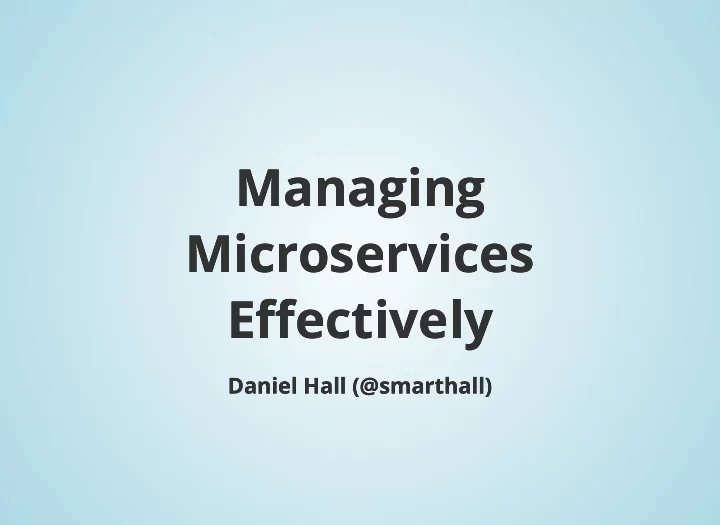

Managing Managing Microservices Microservices E ff ectively E ff ectively Daniel Hall (@smarthall) Daniel Hall (@smarthall)
About Me About Me Systems Engineer at LIFX Making the 'Internet' in the Internet of Things
About This Talk About This Talk This is how we do things at LIFX Feel free to ask questions as we go It works for us, it might not work for you Think about how each bit fi ts into your situation
Step One: Write your apps Step One: Write your apps You may not get input into this part Micro services are popular at the moment Design pattern that works with continuous delivery
Microservices Microservices Try to keep as much state outside your apps Don't make them too small, they're not nanoservices Don't make them too big, they're not milliservices Each service should be Replacable Independently Deployable Have a single capability (billing, authentication) Think about information fl ow and circular dependencies
The Hype Curve The Hype Curve Microservices Jeremy Kemp CC-BY-SA (http://commons.wikimedia.org/wiki/File:Gartner_Hype_Cycle.svg)
Step Two: Packaging Step Two: Packaging All dependencies need to be available Needs to be small or cachable Faster install means faster deployments You might want multiple versions on the same machine Preferably it works in several environments
Docker Docker Filesystem layers stacked on top of each other Uses Linux containers to isolate applications You can run a local Docker registry Security Speed You can run it locally in dev and on your servers Less of 'it works on my laptop' Minuscule performance hit compared to VMs
The Hype Curve The Hype Curve Docker Jeremy Kemp CC-BY-SA (http://commons.wikimedia.org/wiki/File:Gartner_Hype_Cycle.svg)
Step Three: Deployment Step Three: Deployment As fast as possible Preferably minimal interaction Recovery from failures
Mesos/Marathon Mesos/Marathon Mesos manages tasks running on a cluster Marathon coordinates long running jobs You submit a JSON job description to Marathon Marathon handles switching from the old app to new Marathon will also handle task failure and recover Health checks ensure broken tasks get replaced
The Hype Curve The Hype Curve Mesos/Marathon Jeremy Kemp CC-BY-SA (http://commons.wikimedia.org/wiki/File:Gartner_Hype_Cycle.svg)
Extra Credit: Sheduling Extra Credit: Sheduling Some things need to run repeatedly Cron works, but its not really HA HA Crons exist but can be complex Your cluster probably has spare capacity
Chronos Chronos Chronos runs your scheduled tasks in Mesos Uses ISO8601 intervals to specify schedules Use your spare capacity for repeating tasks Can rerun failing jobs Can handle job dependencies Records stats on run times for jobs
The Hype Curve The Hype Curve Chronos Jeremy Kemp CC-BY-SA (http://commons.wikimedia.org/wiki/File:Gartner_Hype_Cycle.svg)
Summary Summary
Demo Demo https://github.com/smarthall/ansible-mesos
Demo Time! Demo Time! All the code is on Github https://github.com/smarthall/ansible-mesos 'vagrant up' will give you a development cluster './init-cluster.sh' will add some sample apps
Recommend
More recommend